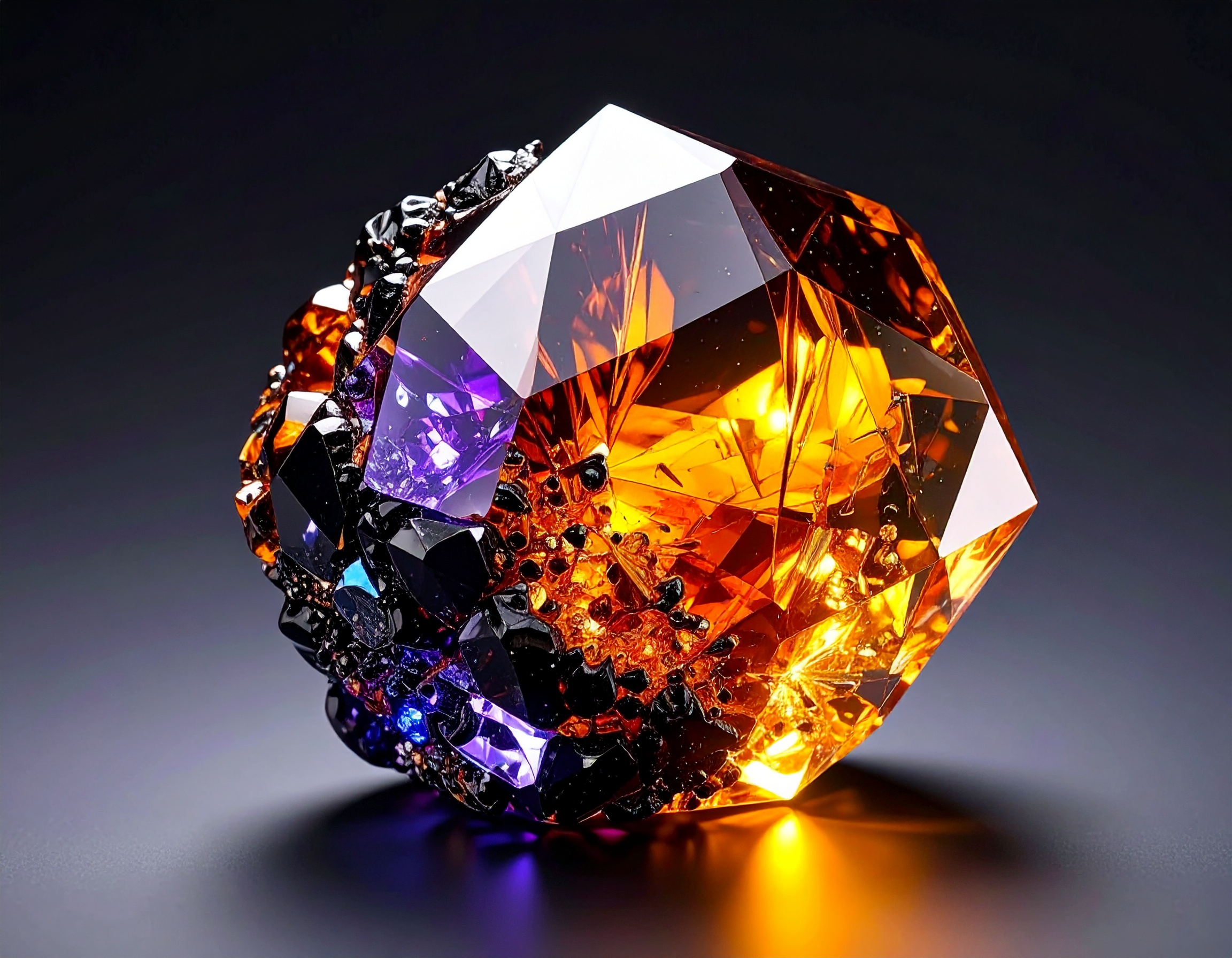Venthmyrrh
Venthmyrrh is a resinous compound exuded from the base of the Cavernroot Tree, a plant believed to feed directly off subterranean tonal veins beneath the Crystal Lake. The resin weeps from the fissures in the bark only once every seven years, during a phenomenon called the Silent Thaw, when the Isle’s ambient tone falls momentarily flat.
Properties
Material Characteristics
- Form: Semi-viscous resin that hardens slowly over time into crystalline flakes.
- Color: Deep amber-black with refractive violet and silver veins.
- Texture: Sticky and heavy when fresh; tacky and brittle after exposure.
- Glow: Faint bioluminescence in darkness, intensifying near tonal activity.
- Odor: Earthy-mineral base with ethereal floral-metallic overtones.
- Top Note: Icy mint-laced myrrh
- Mid Note: Crushed quartz, petrichor, and old brass
- Base Note: Wet stone, burnt lavender, and something almost... musical
Physical & Chemical Properties
The scent deepens when exposed to music or singing in the Talaséan tongue. Overexposure may cause — a gentle euphoric dislocation where the user feels partially embedded in the land’s tone. When diluted, Venthmyrrh can preserve crystal-vegetables for decades. When applied to wounds, it seals with a sting and leaves a faint silver gleam on the skin.
Geology & Geography
It is found only beneath Cavernroot Trees, growing along the liminal cliffroots of the Crystal Lake. The Venthmyrrh draws minerals from deep resonance seams in the isle’s crystalline substructure, and forms naturally in echo-pockets, where residual harmonic vibrations interact with buried biological matter.
Origin & Source
Believed to be a byproduct of tone-mineral digestion by the Cavernroot Tree, a symbiotic species evolved to metabolize dissonant frequencies. Ancient Láenthelin myth claims Venthmyrrh is “the blood of forgotten songs,” a physical remnant of tones that were never sung aloud.
Life & Expiration
Fresh Venthmyrrh retains its potency for 3–5 years when sealed. It begins to harden and lose aromatic complexity after 1 year of exposure to open air. In its crystalline form, it becomes inert unless activated with heat, voice, or Talaséan chant.
Improper storage accelerates tonal spoilage, causing a rancid copper smell and faint auditory dissonance.
History & Usage
History
First discovered during the Pre-Fracture Period by early Láenthelin scouts, who mistook it for weeping tree sap from a wounded island. It was initially feared, then revered as a “dream-balm” after its use in early chant-meditation practices. Studied and formalized by the The Order of the Glassroot circa Spiral Reckoning -22.
Discovery
Officially recorded by Elder Veyscih of the Order after observing harmonic stillness in the Cavernroot Grove. Venthmyrrh was identified as the substance that created “tonal silence pockets”: small zones where sound appeared muffled or delayed.
Everyday use
- Used in:
- Ritual of the First Fracture.
- Preservation of shard-vegetables in crystalline salt rings.
- Anointing sickles, masks, and breath-cups for ritual harvest.
- Scented meditation stones or woven into priest-robes to heighten tonal focus.
Cultural Significance and Usage
- Burned in The Order of the Glassroot rites to induce sacred quietude before a fracture. Considered a tonal stabilizer and emotional conduit.
- Applied in thin lines across the chest of initiates to "open the breath-chord" before their first ritual chant.
- Used in mourning rituals to preserve the last breath of a dying Shardfolk Elder.
- In rare cases, used as a component in bonding vows, two wearers of mirrored Venthmyrrh shards remain tone-aware of one another across great distances.
- Thought to repel tonal corruption when placed in doorways or sleep corners.
Industrial Use
Limited, due to rarity, it is used in microtone amplifiers and crystal-harmonic tools, and studied for use in acoustic memory-encoding devices. In powdered form, it enhances the sensitivity of shard-instruments used in medicine and agriculture.
Refinement
- Refined through:
- Cold extraction in sung stillness.
- Heat-shaping in quartz bowls while exposing it to tonal resonance (no words, only vowels).
- Filtration through shard-silk cloth, woven from crystal-larvae cocoons.
- Result: clear, softly glowing paste or hardened beads of varying purity.
Hazards
Prolonged inhalation has led some to lose their speaking voice for days, replaced by tonal humming. Also, Venthmyrrh is highly sought by smugglers outside of the isle. Inhalig artificially synthesized versions is said to produce a false tone echo- a dangerous dissonance that can cause crystalline poisoning.
Environmental Impact
Overharvesting Cavernroot Trees disrupts local harmonic ecosystems, causing “Dead Breath Zones” where tone won’t resonate and slow deterioration of crystal growth patterns near the lake.
Laws strictly limit how often a root may be tapped; improper collection is a sacred offense punishable by silencing.
Reusability & Recycling
Residual hardened Venthmyrrh can be shaved and reburned as incense, melted down with fresh tree oil for minor ritual use, or crushed and used in tonal pigment for sacred glyphs.
- Cannot be fully restored to original form once spoiled or exposed to false tones.
Distribution
Storage
- Kept in glassroot-lined vials that harmonize with its inner tone.
- Must be shielded from vocal speech and direct harmonic fluctuations.
- Common storage sites include subterranean vaults, known as Whisper Cells, lined with dissonance-absorbing stone.
Law & Regulation
- Only Order-sanctioned harvester-priests may collect or handle unrefined Venthmyrrh.
- Smuggling to outsiders is strictly banned and considered a breach of the Third Harmony.
- Within the Isle:
- Small personal amounts are allowed for devotional or meditative purposes.
- Trade permitted only via the Tonal Exchange Rite, overseen by elders.
- Outside the Isle:
- Illegal substance, often imitated with harmful synthetic replicas.
- Some outsiders consider it a religious narcotic; mischaracterization has caused diplomatic tension.




Comments